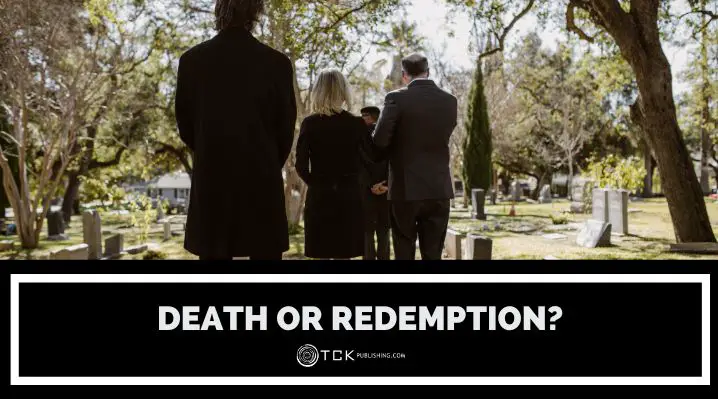
Your villain stands at the crossroads. You hold their fate in your hands. Do they die for their crimes, or do they find a path to redemption?
It’s a choice that shapes everything about your story. How will your readers feel when they close the book? What happens to the story after this critical choice? Will your themes and message land or fall flat?
Why Your Villain’s Fate Matters More Than You Think
Every story needs an ending that feels earned. That’s especially true for your villain. They’ve been a major force in the story. Maybe they’re even the reason the plot exists at all. How you end their arc tells the reader what your story is really about.
Your villain’s exit is a message. Are you writing about justice? Mercy? The power of change? Second chances? And it helps your readers feel something strong: relief, sorrow, or even hope.
Both choices work because they serve their stories’ deeper purposes.
Killing Your Villain
Sometimes your villain needs to die. Here’s when death works best for your story:
Your villain has gone too far. Serial killers, genocidal maniacs, and characters who torture innocents for fun rarely deserve second chances. If your villain was evil to the core, it may feel right to see them fall. Readers want justice for these monsters.
You want clean and clear closure. When your villain dies, the threat ends completely. No worries about sequels or future problems. The survivors can finally rest.
There is a need for consequences. Actions have results. When someone causes massive harm, death shows that choices matter.
You want powerful emotions. The final confrontation between hero and villain often becomes the story’s climax. Speculating who survives can leave your readers breathless. And when readers know that characters can die, every moment feels sharper.
But death isn’t always perfect. It can feel too simple. It might seem like you’re taking the easy way out of complex moral questions. Some readers will always wonder if the villain could have changed.
A death that feels too easy can undercut the emotional weight of the story.
Voldemort in Harry Potter dies as a symbol of evil defeated. His death ends a long fight between good and evil.
Redeeming Your Villain
Redemption is harder to write, but it can lead to a more compelling story. Here’s when to consider giving your antagonist a second chance:
Your villain has sympathetic reasons. Maybe they’re trying to save their family. Perhaps they believe they’re doing the right thing. Villains like these have can grow.
You want to emphasize hope and forgiveness. Depending on your themes and message, you might want to show the possibility of change. That even the worst person can find a better path.
You want deeper characters. What made your villain a villain? Or are their reasons justified? You can dive into their backstories and how they change after being forgiven.
But redemption is hard to earn. If it happens too fast, it feels fake. You also risk angering readers. Some actions feel unforgivable, and if you treat them lightly, your story loses weight.
It works best with villains who were misguided rather than purely evil. Done well, you can catch your audience off guard while making events inevitable.
Zuko in Avatar starts as an enemy but chooses a better path. His slow and believable growth makes him one of the most loved characters in fiction.
Which to Choose: Death or Redemption?
Before you choose your villain’s fate, answer these five questions:
What crimes has your villain committed? Small-scale bullying differs from mass murder. The worse the crimes, the harder redemption becomes to justify.
What motivates your villains? Characters driven by misguided love or desperate circumstances have better redemption potential than those who simply enjoy causing pain.
What is your story really about? A story about justice calls for different endings than one about mercy. Your villain’s fate should reinforce your main themes.
Can your villain actually change? Look at their actions throughout your story. Do they show moments of doubt? Regret? Capacity for growth? Or do they double down on evil every time?
What would satisfy your readers? Consider your genre and audience. Horror readers might expect villain death. Romance readers might prefer redemption.
These questions will point you toward the right choice for your specific story.
When Death Is Redemption
Sometimes you don’t have to choose. A villain’s death can be their redemption.
They pay the ultimate price to make up for past wrongs. They act to protect someone else, stop something worse, or make up for their past.
It’s a bittersweet ending. You show that change is possible, but it often comes with a cost. This kind of arc only works if the villain has shown some humanity along the way. Pure evil can’t pull a sudden 180. That just feels fake.
Darth Vader dies saving Luke. He finds redemption through sacrifice.
Boromir wasn’t a true villain, but he was tempted by the ring and tried to take it. In the end, he gives his life to protect the hobbits. That’s redemption, too.
This option gives you the emotional power of redemption without the complications of keeping an ex-villain alive. But be careful not to glorify suicide. The death should feel like a choice made to save others, not self-punishment.
Know Your Genre and Audience
Different types of stories call for different villain fates. Horror stories often end with the villain’s death. Romance novels frequently feature redemption arcs.
But you can subvert expectations if you do it skillfully. A horror story where the monster finds redemption can be powerful if it fits your themes.
Consider your readers’ cultural backgrounds, too. Some cultures emphasize justice and punishment, while others focus on forgiveness and second chances.
Stay true to your story’s tone and message. A light-hearted adventure story probably shouldn’t end with graphic villain torture. A gritty crime thriller might not suit a feel-good redemption arc.
Your Story Knows the Answer
Don’t kill just for shock value. And don’t hand out undeserved redemption. Both options need consequences. Choose based on what your story needs, not what’s popular right now.
Ask what your villain’s end says about the world you’ve built. Ask what it means to your hero. And make sure the ending leaves your readers feeling something real.
The right choice for your villain should feel inevitable once you make it. Readers should think, “Of course that’s how it should end.”
How did you choose your villain’s end? Share your thoughts below!
If you enjoyed this post, then you might also like:
- How to Write Unlikable Characters (That Readers Can’t Stop Thinking About)
- What Is Your Character Hiding? Crafting Secrets for Deeper Storytelling
- How to Fix Annoying Characters in Your Writing
- Why Your Characters Should Take Their Time to Succeed

Cole is a blog writer and aspiring novelist. He has a degree in Communications and is an advocate of media and information literacy and responsible media practices. Aside from his interest in technology, crafts, and food, he’s also your typical science fiction and fantasy junkie, spending most of his free time reading through an ever-growing to-be-read list. It’s either that or procrastinating over actually writing his book. Wish him luck!
